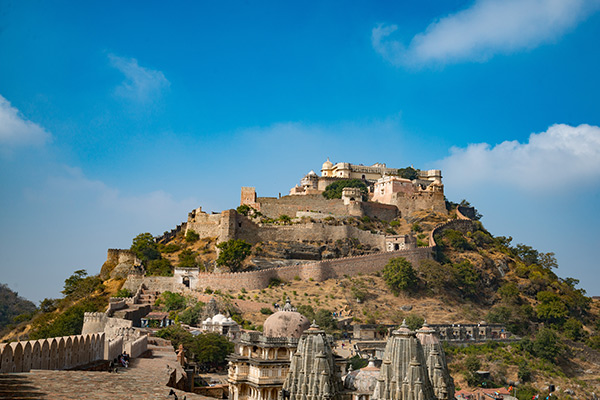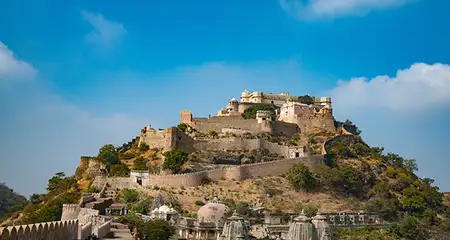Nestled in the foothills of the Aravalli Mountain Range, Kumbhalgarh near Udaipur is a majestic citadel and a major tourist attraction. Surrounded by verdant forests, the fort attracts travelers due to its pristine location and architectural grandeur. Its 36-km long external wall is the second longest wall in the world, after the Great Wall of China. Are you a history buff looking to visit heritage places from the bygone eras? Then chalk out your itinerary, book your hotels in Udaipur, and get set to explore this wondrous hill fort in Rajasthan.
Before you start out on this expedition, take some time to read this blog. It gives you the history, timings, entry fee, and other interesting details about the majestic Kumbhalgarh Fort near Udaipur.
Kumbhalgarh Fort Information:
| Type | Mewar Fortress |
| Location | Kumbhalgarh, Rajsamand district |
| Timings | 9:00 am to 6:00 pm; every day |
| Entry Fee | ₹ 10 for Indians; ₹ 100 for foreigners |
| Video Camera | ₹ 25 |
| Built in | 15th century, between AD 1443 and 1458 |
| Commissioned by | Kumbhakarna or Rana Kumbha of the Mewar kingdom |
| Architectural Style | Rajput military hill architectural style |
| Architect | Mandan |
| Status | UNESCO World Heritage Site |
| Distance from Udaipur | 103 km approx. |
| Also Known as | Kumbhal Fort |
| Altitude | 3,600 ft. above sea level |
| Length of External Wall | 36 km |
| Special Tip | The colossal fort requires hours of walking, so a pair of comfortable shoes is recommended |
Kumbhalgarh: History
It is believed that the original Kumbhalgarh Fort dates back to the 6th century and was built by King Samprati of the Maurya Age. However, due to the lack of any recorded evidence, the history of the fort from its origins till invasion by Alauddin Khilji in 1303 AD remains vague.
The fort as we see today was built by Kumbhakarna aka Rana Kumbha of Mewar kingdom in the 15th century. It was designed by a famous architect of that period, named Mandan. According to local legends, Rana Kumbha faced many difficulties during the construction of the fort that he nearly abandoned it. Then a holy man told him that all these problems would end if a pure-hearted man willingly sacrificed his life for the construction. On hearing this, the king was disappointed and that was when the holy man beheaded himself and sacrificed his life. After that, the king was able to build the fort without any problems. It is believed that the entrance to the fort marks the place where the holy man’s head fell.
That’s the legend part of it. Historically too, the fort played a major role in shaping the region’s past. Thanks to its strategic location, Kumbhalgarh was used as a safe refuge by the rulers of Mewar at times of threat or danger. It has remained witness to many significant events that have shaped the region’s history like that Maharana Pratap was born in this citadel. The fort provided shelter to the infant Prince Udai of Mewar after Chittor fell under siege. Though the fort came under attack from various rulers and invaders, it remained invincible except for once when, in 1576, it was conquered by Mansingh I, the general of Emperor Akbar. Later, the fort was taken over by the colonial rulers before it finally came under the aegis of the government of Rajasthan.
Kumbhalgarh Fort Architecture
Due to its mountainous location, Kumbhalgarh was built in the Rajput military hill architectural style that makes use of the defensive properties of the terrain. The fort is built on a hilltop at a height of about 3600 feet above sea level and enveloped by a 36-km long wall with seven fortified gateways. The wall, which is listed among the longest walls in the world, is often called the Great Wall of India.
The frontal walls of the fort have a thickness of 15 feet. There are more than 360 temples inside the fort, out of which 300 are ancient Jain temples and the others are Hindu shrines. Though several additions were made to the fort by the rulers of Mewar over the years, the original structure exists even now.
Kumbhalgarh Fort: Today
Today, Kumbhalgarh is one of the most popular forts near Udaipur and is visited by tourists all year round. Every year, a three-day annual festival is organized inside the fort by the Rajasthan Tourism Department to honor Maharana Kumbha’s passion for art and architecture. Various dance events, concerts, heritage fort walks, light and sound shows, and other activities form the main attractions of this annual festival.
In 2013, the Kumbhalgarh Fort and five other forts in Rajasthan were granted the UNESCO World Heritage Site status. Kumbhalgarh Fort may not be in its best shape today, but it’s worth a visit for its unique architectural style and historical significance. You can get splendid views of the surroundings from the terrace of the fort’s palace, including the sand dunes of the Thar Desert. In the evenings, the fort is marvelously lit up for some time.
Things to See in the Kumbhalgarh Fort Complex
The sprawling fort complex has many well-preserved structures that narrate the saga of its rich past. The things to see in Kumbhalgarh include:
- Kumbha Palace, the residence of the king
- Badal Mahal, a two-storied structure built by Rana Fateh Singh
- Lakhola Tank, constructed by Rana Lakha
- Ram Pol, the main gateway to the fort
- Aaret Pol, Hanuman Pol, and Halla Pol, other major gateways to the fort
- Badshahi Bavdi, a water tank
- Hindu temples, including the ancient Ganesha temple and Neel Kanth Mahadeva temple
- Jain temples, including the Parsva Natha temple, Golera Jain temple, Mamdeo temple, Mataji temple, Surya Mandir, and Pital Shah Jain temple
- Chattris, Baoris, and water reservoirs
Kumbhalgarh Light and Sound Show
Every evening, the fort wakes up to a fascinating display and narration of its history through a light and sound show. The Kumbhalgarh light and sound, held in Hindi, is a key attraction for visitors who want a glimpse into the fort’s past.
- Duration: 45 mins
- Timings: 6:45 pm to 7:30 pm; every day
- Tickets: ₹ 100 for Indians; ₹ 200 for foreigners
Lesser Known Facts about Kumbhalgarh Fort
- Kumbhalgarh Fort is one of the largest fort complexes in the whole world and the second largest fort in India, the first being the Chittorgarh Fort.
- The fort’s walls are so wide that eight horses can walk abreast through it.
- You have to cross seven massive gates before entering the fort. Each consecutive gate is narrower than the previous one. The gates were constructed in this manner so that elephants and horses can’t enter the fort beyond a certain point.
- King Samprati, who is believed to be the builder of the original fort, was the grandson of Emperor Ashoka.
Attractions near Kumbhalgarh Fort
- Kumbhalgarh Wildlife Sanctuary (3 km)
- Ganga Govrdhan Museum (3.3 km)
Kumbhalgarh, beyond any doubt, is a fascinating destination where several stories from the past await you, to be told and retold. So, go ahead and enjoy a trip to this historical fort near Udaipur.




























